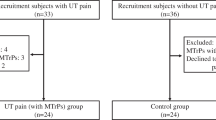Abstract
This aim of this study was to characterize upper and lower trapezius muscle activity for patients experiencing frozen shoulder syndrome (FSS) compared to asymptomatic subjects. Fifteen patients suffering from unilateral FSS and 15 asymptomatic subjects voluntarily participated in this study. Data were gathered on electromyographic (EMG) activity obtained from the upper and lower trapezius muscles during maximal static arm elevations at six different testing positions: 60 and 120° of flexion, abduction in the frontal plane, and abduction in the scapular plane. The group with FSS revealed increased upper trapezius EMG activity at the 60° (mean difference=12%, p<0.003) and 120° (mean difference=24%, p<0.004) testing positions, and increased lower trapezius EMG activity at the 120° testing positions (mean difference=6%, p<0.002), compared to asymptomatic subjects. Higher ratios of the upper trapezius to lower trapezius EMG activity were also found in the patient group (p<0.0005) compared to asymptomatic subjects. The results of this study indicate that the increased trapezius muscle activity may contribute to scapular substitution movement in compensation for impaired glenohumeral motion in patients with FSS. The insufficiency of the increased lower trapezius muscle activity should be an important consideration in the rehabilitation of patients experiencing FSS.


Similar content being viewed by others
References
Hannafin JA, Chiaia TA (2000) Adhesive capsulitis: a treatment approach. Clin Orthop 372:95–109
Murnaghan JP (1990) Frozen shoulder. In: Rockwood CA, Frederick A, Matsen III (eds) The shoulder. WB Saunders, Philadelphia
Reeves B (1975) The natural history of the frozen shoulder syndrome. Scand J Rheumatol 4:193–196
Wadsworth CT (1986) Frozen shoulder. Phys Ther 66:1878–1883
Watson L, Dalziel R, Story I (2000) Frozen shoulder: a 12-month clinical outcome trial. J Shoulder Elbow Surg 9:16–22
Grey RG (1981) The natural history of idiopathic frozen shoulder. J Bone Joint Surg 60:149–152
Griggs SM, Ahn A, Green A (2000) Idiopathic adhesive capsulitis: a prospective functional outcome study of nonoperative treatment. J Bone Joint Surg 82:1398–1407
Melzer C, Wallny T, Wirth CJ, Hoffmann S (1995) Frozen shoulder—treatment and results. Arch Orthop Trauma Surg 114:87–91
Babyar SR (1996) Excessive scapular motion in individuals recovering from painful and stiff shoulders: causes and treatment strategies. Phys Ther 76:226–238
Vermeulen HM, Stokdijk M, Eilers PH, Meskers CG, Rozing PM, Vliet Vlieland TP (2002) Measurement of three dimensional shoulder movement patterns with an electromagnetic tracking device in patients with a frozen shoulder. Ann Rheum Dis 61:115–120
Sahrmann S (2002) Diagnosis and treatment of movement impairment syndromes. Mosby, St. Louis
Ludewig PM, Hoff MS, Osowski EE, Meschke SA, Rundquist PJ (2004) Relative balance of serratus anterior and upper trapezius muscle activity during push-up exercises. Am J Sports Med 32:484–493
Ludewig PM, Cook TM (2000) Alterations in shoulder kinematics and associated muscle activity in people with symptoms of shoulder impingement. Phys Ther 80:276–291
Johnson GR, Bogduk N, Nowitzke A, House D (1994) The anatomy and actions of the trapezius muscle. Clin Biomech 9:44–50
Bagg SD, Forrest WJ (1986) Electromyographic study of the scapular rotators during arm abduction in the scapular plane. Am J Phys Med 65:111–124
Ballantyne BT, O’Hare SJ, Paschall JL, Pavia-Smith MM, Pitz AM, Gillon JF et al (1993) Electromyographic activity of selected shoulder muscles in commonly used therapeutic exercises. Phys Ther 73:668–677
Paine RM, Voight M (1993) The role of the scapula. J Orthop Sports Phys Ther 18:386–391
Heckathorne CW, Childress DS (1981) Relationships of the surface electromyogram to the force, length, velocity, and contraction rate of the cineplastic human biceps. Am J Phys Med 60:1–19
Zipp P (1982) Recommendations for the standardization of lead positions in surface electromyography. Eur J Appl Physiol 50:41–54
Hislop H, Montgomery J (1995) Daniels and Worthingham’s muscle testing: techniques of manual examination. WB Saunders, Philadelphia
Bohannon RW (1988) Make tests and break tests of elbow flexor muscle strength. Phys Ther 68:193–194
van der Helm FC (1994) Analysis of the kinematic and dynamic behavior of the shoulder mechanisms. J Biomech 27:527–550
Soderberg GL (1992) Selected topics in surface electromyography for use in the occupational setting: expert perspectives. US Department of Health and Human Services, Washington, DC
Soderberg GL, Knutson LM (2000) A guide for use and interpretation of kinesiologic electromyographic data. Phys Ther 80:485–498
Author information
Authors and Affiliations
Corresponding author
Rights and permissions
About this article
Cite this article
Lin, JJ., Wu, YT., Wang, SF. et al. Trapezius muscle imbalance in individuals suffering from frozen shoulder syndrome. Clin Rheumatol 24, 569–575 (2005). https://doi.org/10.1007/s10067-005-1105-x
Received:
Accepted:
Published:
Issue Date:
DOI: https://doi.org/10.1007/s10067-005-1105-x




